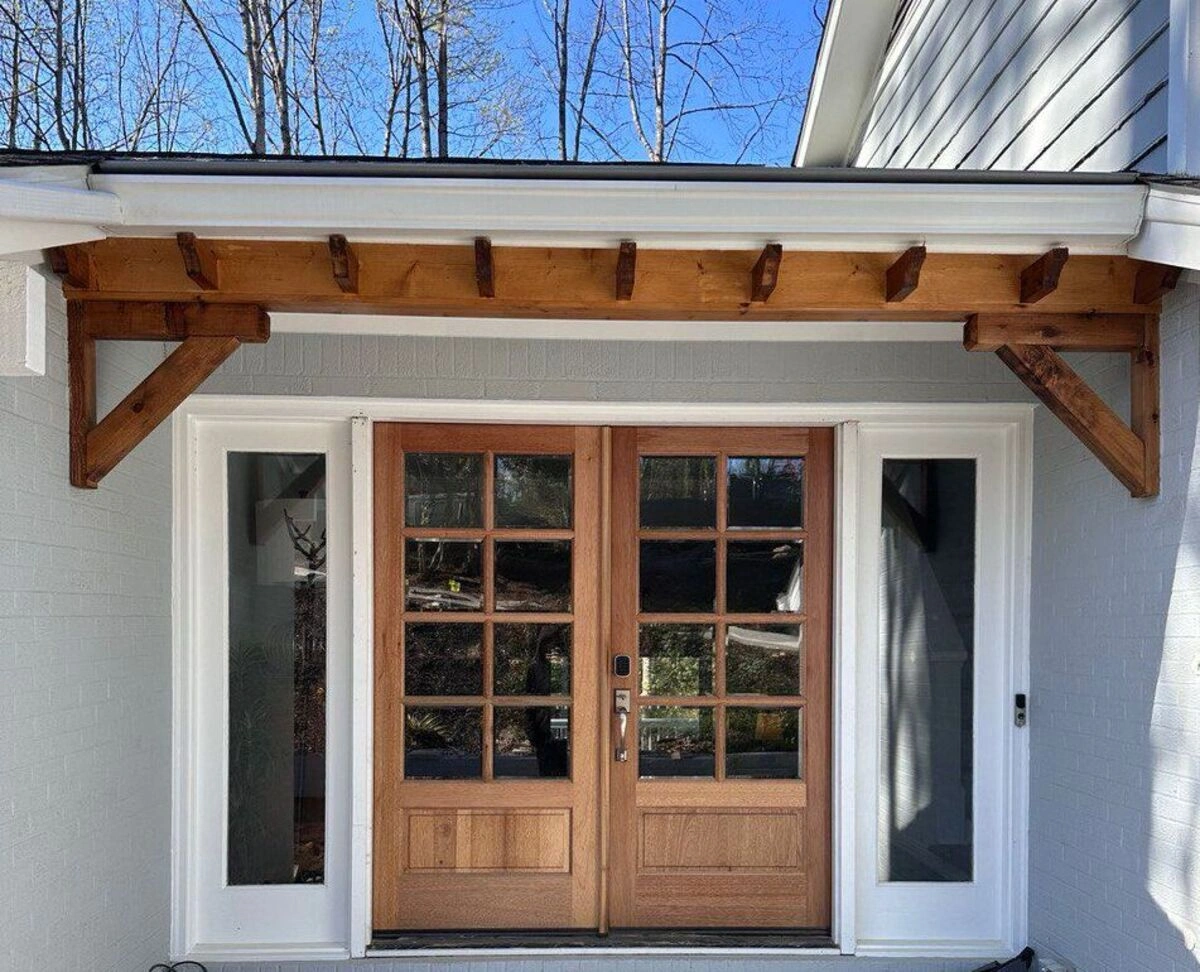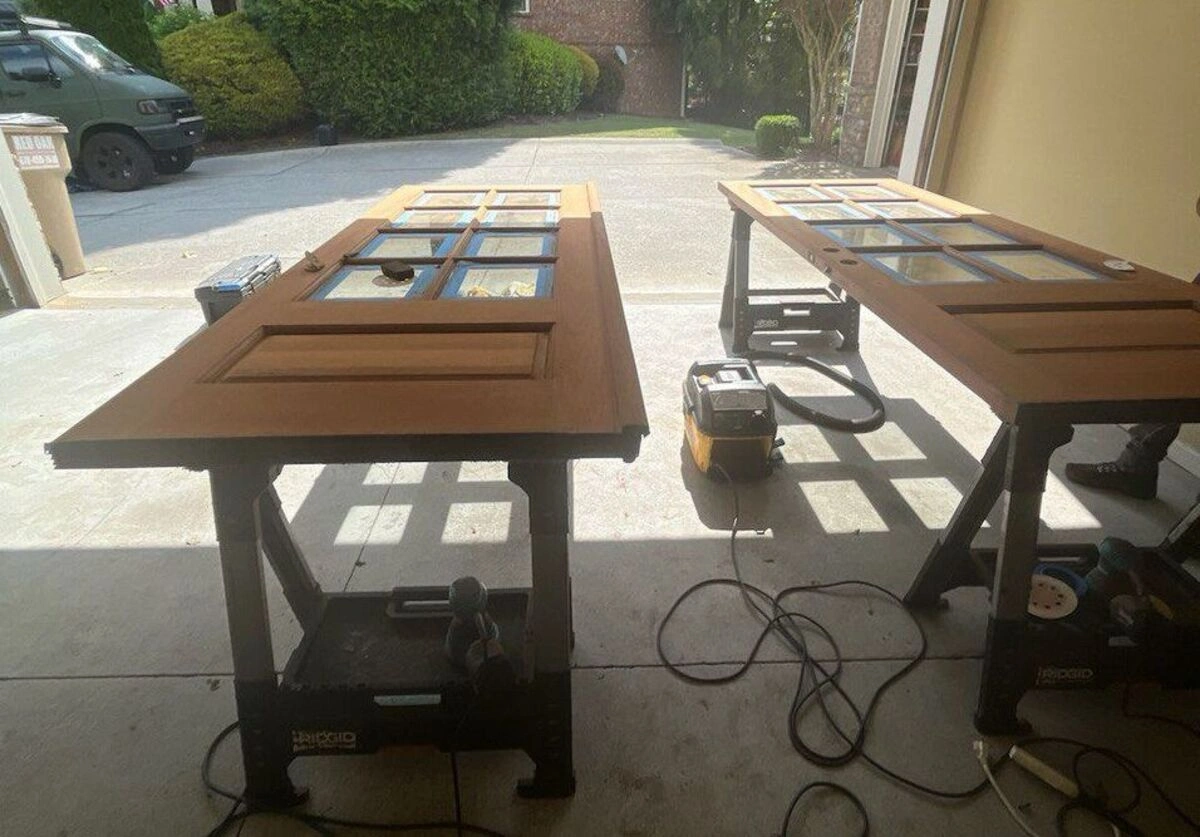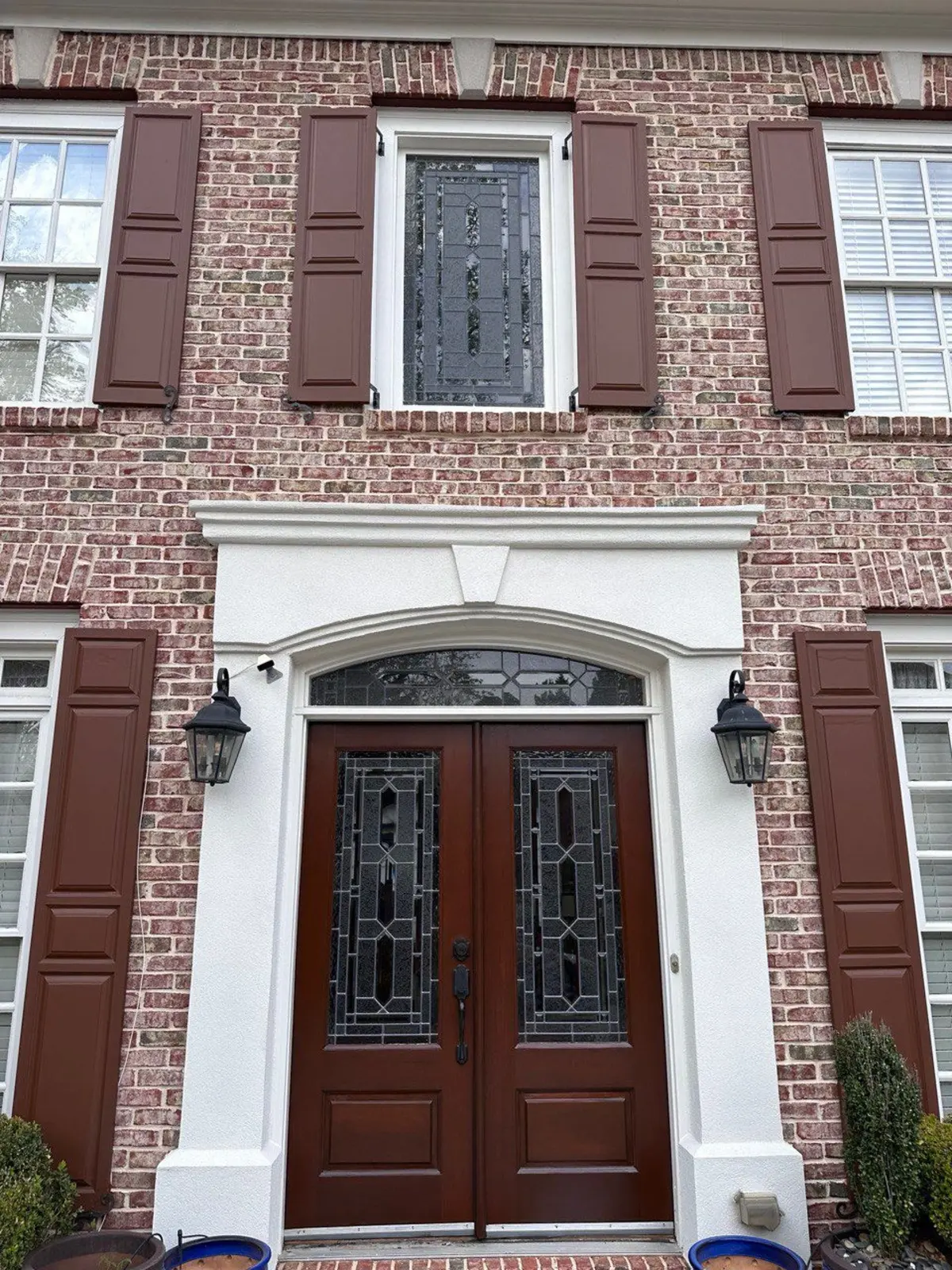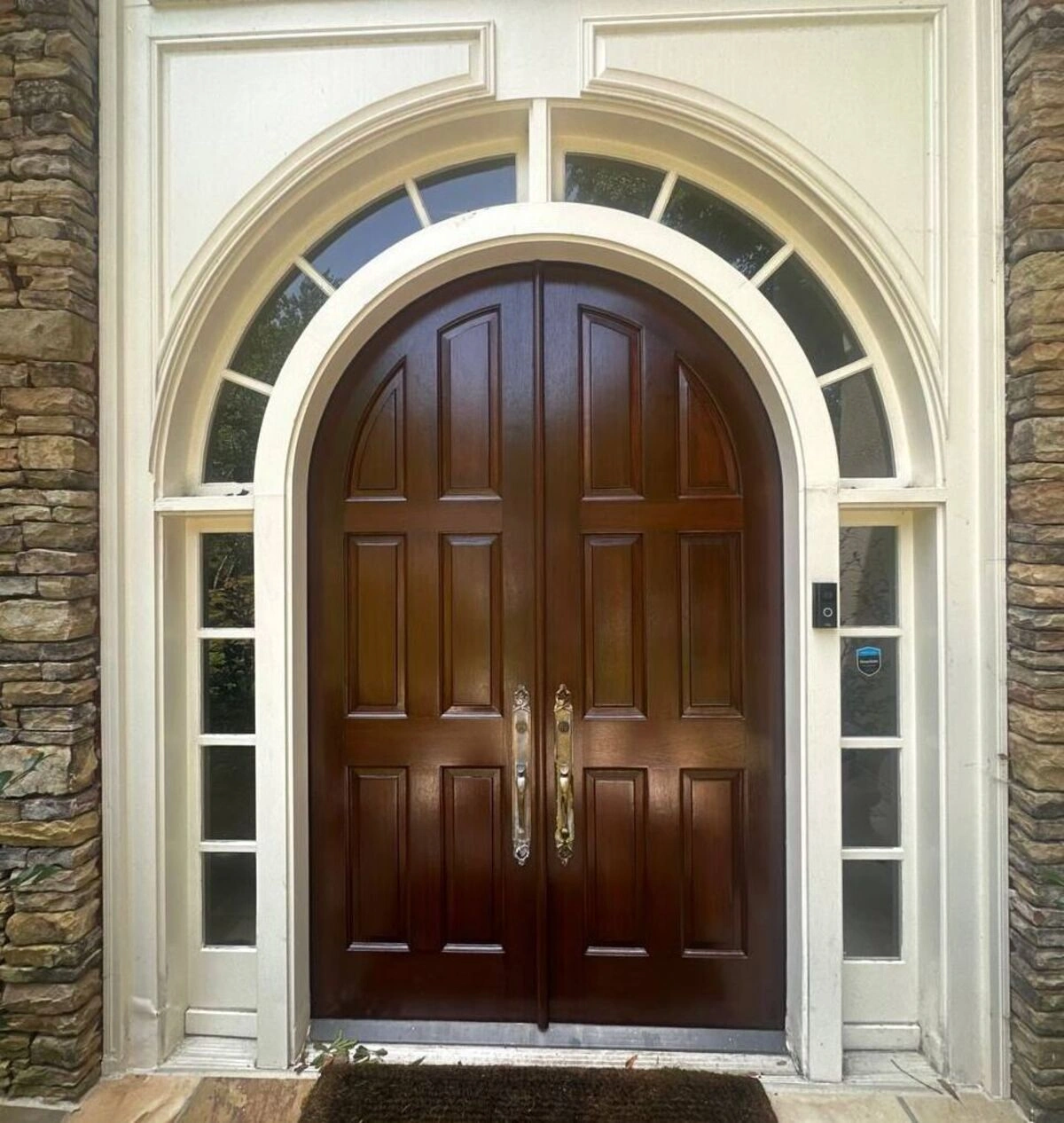Table of Contents
The Ultimate Guide to Door Refinishing
Door refinishing is a unique way to breathe new life into your home or office. It’s a simple yet transformative process that can significantly impact the overall aesthetics of your space. In this ultimate guide, we’ll dive deep into the process, importance, and considerations of door refinishing.
Refinishing a wood door restores its natural beauty, protects it from Florida sun and humidity, and adds curb appeal without replacing the entire unit. This guide explains the full wood refinishing process, when to choose refinishing vs. resurfacing, common mistakes to avoid, timelines, maintenance tips, and how to pick the right professional. We also include practical details homeowners ask for—like construction material weights, plywood weight per square foot, and PSF rating—so your door stays safe and solid after upgrades.
Understanding Door Refinishing
Before we delve into the specifics, it’s important to understand what door refinishing entails and why it’s a valuable process for homeowners and business owners alike.
What is Door Refinishing?
Door refinishing is a process that restores the appearance and structural integrity of wooden doors. It involves stripping the old finish, repairing any damages, sanding the surface, applying a new stain, and sealing the door for protection against future wear and tear.
Why is Door Refinishing Important?
Doors are not merely functional elements of a building; they also contribute significantly to the property’s aesthetic appeal. Over time, doors can become dull, damaged, or outdated. Refinishing can restore their original beauty and even give them a new look, boosting the overall appeal of your home or business.
Read it: Top-Rated Door Refinishing Services in Fort Lauderdale
The Door Refinishing Process
Door refinishing is a multi-step process that requires skill, patience, and the right materials. Here are the typical steps involved in door refinishing:
Evaluation
The first step in the door refinishing process is a thorough evaluation of the door’s condition. This involves checking for signs of damage, wear and tear, and identifying the type of wood and finish previously used.
Stripping
Once the door has been evaluated, the old finish is stripped away using a chemical stripper. This reveals the raw wood underneath, ready for restoration.
Sanding
After stripping the door, the next step is sanding. Sanding removes any remaining finish and smooths out the wood surface, preparing it for the new stain.
Read it: Door Refinishing Miami, FL & Nearby Areas
Staining
The door is then stained with the chosen color. The stain penetrates the wood and gives the door its new look. Depending on the desired result, several coats of stain may be applied.
Sealing
The final step in the door refinishing process is sealing the door. A sealant provides a protective layer on the door, preventing damage from sunlight, moisture, and daily use.
Factors to Consider When Refinishing a Door
There are several factors to consider when refinishing a door, including the type of wood, the condition of the door, and the desired outcome.
Read it: Door Refinishing West Palm Beach, Palm Beach Gardens & Wellington
Type of Wood
The type of wood used for your door can affect the refinishing process. Different types of wood respond differently to stains and finishes, so it’s important to choose the right products for your specific door.
Condition of the Door
The condition of the door is another important consideration. If the door is severely damaged or rotten, it may need more extensive repairs or even replacement before refinishing.
Desired Outcome
Finally, consider what you want to achieve with the refinishing. Whether you want to restore the door to its original state, or give it a completely new look, your goals will guide the refinishing process.
Choosing the Right Finish
With numerous finish options available, from glossy to matte, it’s crucial to pick the one that aligns with your style and the door’s intended function. The finish can dramatically impact the door’s final appearance and durability.
Additional Services
At DoorStain.com, we offer a range of services to suit all of your wood and door refinishing needs. Door refinishing services extend beyond doors and include general wood refinishing, table refinishing, door repair, door polishing, and metal door refinishing. No matter your refinishing needs, we’ve got you covered!
Common Questions About Door Refinishing
Be with us in this stage:
How to Refinish a Wood Door Without Removing It
Yes, you can refinish a wood door in place as long as the hinges are secure and the weather is dry. Clean and degrease, mask hardware and surrounding trim thoroughly, then scuff-sand to dull the old finish. Apply stain in thin, even coats, wipe excess to prevent lap marks, and finish with an exterior-grade clear coat. Keep the door closed during drying to minimize dust. If the finish is failing badly or deep repairs are needed, removing the door is safer.
How to Restain Wood Doors for a Fresh Look
When the current finish is intact but faded, restaining is often enough. Clean the surface, perform a uniform 220–320 grit scuff-sand, optionally water-pop the grain for deeper color, then test color on a hidden area. Gel stains are forgiving on vertical surfaces and over existing finishes. Seal with a sanding sealer, denib, then add two protective coats.
What Is the Difference Between Door Refinishing and Door Resurfacing?
Door refinishing restores the original wood by sanding, staining, and top-coating. Door resurfacing adds a new veneer or uses fillers to level severe damage before recoloring—useful when the face is too far gone. Refinishing preserves historic character and is typically faster; resurfacing hides heavy defects and can change the style.
Exterior and Specialty Refinishing
This stage includes the following:
Exterior Door Refinishing for Long-Lasting Protection
Florida’s UV, salt air, and afternoon storms demand UV-resistant stains and marine-grade clear coats (spar varnish or exterior urethane). After proper prep, apply two thin stain coats with full dry time and at least two clear coats, maintaining with a light scuff and refresher coat every 12–24 months—faster on south- and west-facing entries.
Historic Door Repair and Restoration Tips
For historic doors, keep methods reversible when possible. Tighten joinery, consolidate soft wood with epoxy where appropriate, and replicate original tones. Avoid aggressive sanding that softens profiles. Document hardware and existing finishes, and follow local preservation guidance before work begins.
Cabinet Refinishing in Hallandale and Nearby Areas
We also offer cabinet refinishing in Hallandale and nearby communities (Aventura, Hollywood, Sunny Isles, Dania Beach). Our wood refinishing process includes deep degreasing, scuff-sand, color sampling, and a humidity-tough clear finish that refreshes kitchens without replacement.
Read it: Door Refinishing Services in Boca Raton and Surrounding Areas
Finding Door Refinishing Services Near You
Stay with us throughout this stage:
Wood Door Refinishing Near Me – What to Look For
Evaluate before/after galleries, product data sheets (stains and clear coats), proof of insurance, and written timelines. Ask for a clear explanation of surface prep, stain system, and maintenance schedule—pros should describe their steps in detail and offer on-door samples.
Door Staining Near Me – Choosing Local Experts
Local specialists understand UV exposure, sea breeze, and rain patterns. They’ll tailor stain color and topcoat sheen to your entry’s direction and coverage and schedule around humidity for best curing. Ask for on-site swatches to approve color under real light.
DIY vs. Professional Refinish Door Services
DIY suits light cosmetic refreshes—expect a full weekend for prep, stain, and clear with multiple dry windows. Hire a professional refinish door service for sun-damaged or historic doors, heavy stripping, epoxy repairs, color matching, and warranty-backed results.
Tools and Materials Needed for Refinishing a Door
Safety first: respirator (organic vapor cartridges), safety glasses, and gloves. Essentials: orbital sander, sanding blocks, 120–320 grit papers, high-quality brushes/foam pads, clean rags, painter’s tape, drop cloths, stain, sanding sealer, and exterior clear coat. Account for construction material weights when lifting or removing slabs—solid wood doors are heavy—and ensure hinges/stands can handle the weight of building materials safely.
How Long Does It Take to Refinish a Wood Door?
A light scuff-and-refresh can be completed in one day with overnight cure. Full strip, stain, and multi-coat protection typically takes one to two days, plus cure time—longer in humid weather. Plan for extra drying windows during Florida’s rainy season.
Costs, Timeline, and Common Mistakes
Now, we will look at costs, timeline, and common mistakes:
What Affects the Cost of Door Refinishing?
Price depends on door size and species, current condition (stripping vs. scuff-sand), number of panels/profiles, glass or ironwork, repair needs, chosen stain system, and the number of clear coats. Coastal exposure and access (condos vs. single-family homes) can also influence cost.
Common Mistakes to Avoid
- Skipping surface cleaning—oils and sunscreen can cause fisheyes and adhesion failure.
- Over-sanding edges—this rounds crisp profiles and thins veneer on some doors.
- Rushing recoat windows—solvent entrapment leads to soft or cloudy finishes.
- Ignoring sun exposure—insufficient UV blockers cause premature fading.
- Neglecting maintenance—exterior doors need refresher coats to stay protected.
Maintenance and Aftercare
- Clean gently with a mild, non-ammonia cleaner; avoid abrasive pads.
- Inspect quarterly for dry film cracks or dulling on sun-facing sections.
- Scuff and apply a refresher coat every 12–24 months (faster on south/west exposures).
- Use mats and covered entries to reduce splash-back and grit.
- Keep sprinklers from wetting the door—standing water shortens finish life.
Construction Weights and Ratings
Next, we will look at construction weights and ratings:
Why Construction Material Weights Matter in Door Projects
Door mass affects hinge capacity, closer tension, and long-term alignment. When adding glass lites, metal grills, or heavy hardware, verify the building material weights so the slab doesn’t sag and fasteners hold over time.
Plywood Weight per Square Foot and Its Impact
Plywood sheathing or backing adds load. As a rule of thumb, many 3/4-inch panels are around ~2 lb per sq ft (species and moisture vary). Knowing plywood weight per square foot helps you select hinges and fasteners and avoid racking or latch misalignment.
Understanding PSF Rating for Building Materials
PSF (pounds per square foot) expresses the distributed load over an area. It’s useful when attaching panels, glass, or decorative iron to a door. Match hinges, screws, and anchors to the expected psf rating and total weight of building materials to keep the assembly secure.
Common Weights of Building Materials Used in Door Refinishing
- Solid wood entry door (no glass): ~50–120 lb depending on thickness and species.
- Decorative glass inserts: typically add ~1–3 lb per sq ft.
- Wrought-iron grills/hardware: ~2–10 lb per component.
Note: These are approximate ranges; consult manufacturer specs when precision matters.
Door Refinishing Services in Florida
We proudly serve Miami, Miami Beach, Brickell, Coral Gables, Key Biscayne, Fort Lauderdale, Hollywood, Hallandale Beach, Aventura, Boca Raton, West Palm Beach, Delray Beach, Pompano Beach, and surrounding areas. If you searched for wood door refinishing near me or door staining near me, we likely cover your neighborhood.
Why Choose DoorStain.com?
At DoorStain.com, we combine years of experience, unparalleled skill, and top-quality materials to deliver exceptional results. We use the highest quality of stains and clear coats imported from international companies, ensuring that your door will not only look brand new but also last longer.
Our Process
We’ve honed our refinishing process to perfection over the years, using secret techniques to ensure your door achieves the thick, protective glaze finish we’re famous for. Every door we work on receives the same careful attention to detail, resulting in a stunning, long-lasting finish.
Our Commitment
At DoorStain.com, your satisfaction is our top priority. We pride ourselves on offering reasonable prices without compromising on quality, promising that our quotes will always be lower than any of our competitors.
Conclusion
Door refinishing is a powerful way to enhance your property’s aesthetic appeal and maintain the structural integrity of your doors. With the right expertise and materials, you can transform any old, worn-out door into a beautiful and durable entranceway. Whether you’re looking to restore an antique door or give a new look to a modern one, door refinishing is an investment in your property’s value and appeal.
FAQs
How long does door refinishing take?
The duration of the door refinishing process varies depending on the door’s size and condition, as well as the specific refinishing techniques used. However, a standard door refinishing project typically takes between 2 to 5 days.
Can all types of doors be refinished?
While door refinishing is commonly performed on wooden doors, other types of doors, such as fiberglass and metal doors, can also be refinished, given the right tools and techniques.
How often should doors be refinished?
The frequency of door refinishing depends on several factors including the type of wood, the quality of the original finish, the door’s exposure to the elements, and the desired look. However, a good rule of thumb is to refinish exterior doors every 2-5 years and interior doors every 5-7 years.
Is door refinishing a DIY project?
While it’s possible to DIY door refinishing, the process requires specific tools, materials, and skills to achieve professional-looking results. Mistakes can be costly and time-consuming to fix, so it’s often best to hire professionals like DoorStain.com.
Why should I choose DoorStain.com for door refinishing?
DoorStain.com offers superior craftsmanship, high-quality materials, and competitive pricing. Our team’s expertise and dedication to customer satisfaction set us apart in the door refinishing industry
Which stain colors work best on mahogany or oak?
Mahogany pairs well with warm medium-to-dark browns; oak can go from honey tones to deeper walnut shades. Always test samples on your door, viewing them at different times of day to see how sunlight changes the perception.
How many coats of clear should I use?
Two to three thin coats are typical for exterior doors. More is not always better—excessively thick films can crack. Follow manufacturer recoat windows and scuff between coats as directed.
Can I switch from oil-based to water-based products?
Yes, but surface prep and compatibility are critical. Many pros stick with exterior oil-based or marine varnishes for UV resilience on sun-exposed entries. If switching systems, perform a full strip or use a compatible bonding primer/undercoat per the product’s technical data sheet.
Get a Fast, Professional Quote
Ready to refresh your entry? Send a photo of your door in natural light and include the street orientation (north, south, east, or west). We’ll recommend the right stain system and provide a clear timeline. Our team completes on-site refinishing with minimal disruption and long-lasting protection.




